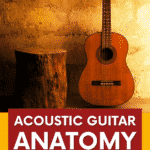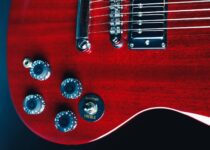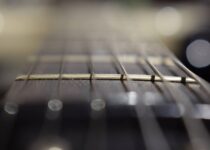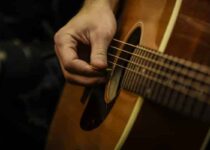So you’ve decided to pick up the acoustic guitar. But wait, do you know all the parts of the instrument you’re holding?
You wouldn’t go to a foreign country without learning some basics of the local language first. It’s the same with an acoustic. Once you learn the acoustic guitar anatomy and the related terminology, it will be a lot easier to learn to play confidently. You won’t hesitate when someone asks you, “What kind of fretboard do you have?”
Acoustic guitars come in many different shapes, sizes, and materials. But they all have some common components of guitar anatomy. And once you learn the anatomy of an acoustic guitar, you’ll have a better idea of how each element affects the sound and playing experience.
Let’s deep-dive into every nook and cranny of this beautiful instrument, and you’ll be a master before you know it.
Post Contents
Anatomy Of An Acoustic Guitar
We’ll tackle all the parts of the acoustic guitar one by one. From the headstock at the top, to the body of the guitar, to the bridge at the bottom.
Headstock

The headstock, also called the ‘peg head’, lies at the top of the guitar neck and flaunts your cool guitar logo (the manufacturer’s branding). It holds the tuning pegs (hence the name peghead) and the keys used for tuning the guitar.
A headstock can be straight, tilted, or scarfed, and will come in various shapes based on the manufacturer and model.
Straight headstocks use a single solid piece of wood and are inexpensive to make.
Tilted headstocks are more commonly seen in acoustics. The wood is slightly bent, with a ‘pitch’ of 10 to 15 degrees. This can help strings stay in tune and sustain better, since there is more pressure on them.
Scarfed headstocks are a close cousin of the tilted headstock and are made of two pieces of wood. This makes them more robust.
Some modern manufacturers like Kiesel have even come up with headless acoustic guitars that don’t have a headstock!
Tuning Pegs (or machine heads)

Tuning pegs are attached to the headstock. As the name suggests, tuning pegs are used to adjust the tension in your strings when tuning your guitar to different pitches. They also go by the name of tuning machines, tuners, or machine heads.
One tuning peg hosts one string. The string end is wrapped around the tuning peg. On a normal acoustic guitar head, you will find 6 tuning pegs, one for each string. But for 12-strings, you’ll find 12 machine heads.
Machine heads are comprised several individual components: the worm gear, the tuning knob, the capstan, and the pinion gear.
The tuning knob, also called a tuning post, hosts a cylindrical peg, which sits inside a pinion gear. Depending on the direction the knob is turned, the tension either increases or decreases in the individual string.
The worm gear is attached to the tuning knob. The tuning knob turns the pinion gear which in turn winds the capstan.
There is a hole in the capstan through which the string goes in. As the capstan is wound, the string gets tightened.
The gear ratio describes the amount of tension that is applied per turn of the knob. A higher gear ratio implies a finer control over the tuning of your guitar.
Tuning machines can be either sealed-gear or open gear. Classical guitars are more likely to have open gear tuners, while modern acoustics have sealed gears.
Nut
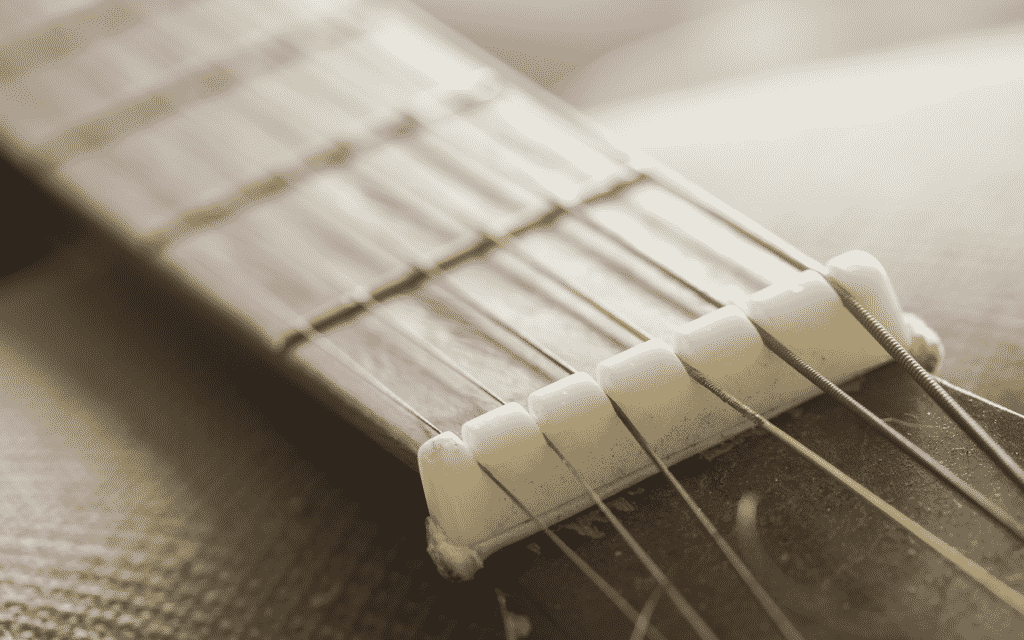
The nut is placed at the headstock end of the guitar’s fretboard. It holds the strings at the top of the neck, and is typically glued to the headstock.
It can be made from bone, wood, graphite, TUSQ, brass, ivory (not common anymore), or rigid plastic and is most commonly black or white in color.
Despite its simple appearance, the nut plays a pretty important role, and can make or break the sound of your guitar.
Open guitar strings vibrate between the nut and the bridge. So a good nut allows the strings to vibrate freely and have better sustain and clarity.
The nut width also determines the spacing between each string, since the strings fit into predetermined slots cut into the nut. The nut slot depth depends on the thickness of the string.
Determining the nut slot depth is a work of delicate balance. If the nut is too shallow, the strings come out of their slot frequently. If the slot is too deep, the strings come in contact with the fret wires creating fret buzz (a nuisance for all guitarists).
A narrow nut slot also causes unsteady tuning. If more stress is added to the string, such as when making a bend, the string will not readily glide through the nut slot.
Neck
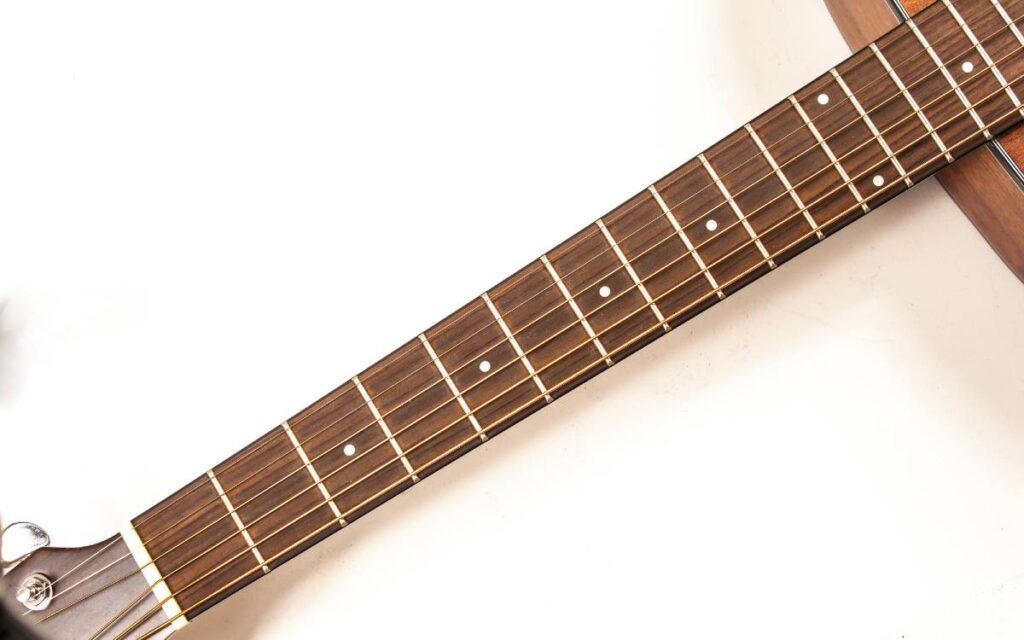
The neck of the guitar is a vital component. The neck hosts the headstock, tuning machines, fingerboard, fret inlays, truss rod, and strings.
The shape or width of the neck determines what style of music the guitar is more fit for. The shape of the neck is highly variable and can resemble anything from a C shape to a V shape to a U shape or anything in between. It can even be asymmetrical!
The shape of the neck can influence how comfortable you are playing your instrument. The neck needs to be strong enough to handle tension without breaking, yet light enough to not weigh down the guitar.
The rigidity of the neck greatly determines the quality of the guitar. A little flexibility to slightly bend the neck and change the pitch of a note is advantageous, especially in blues or rock songs.
A wider neck means more fretboard area. Classical and fingerstyle guitars have a wider neck area that leaves more space between individual strings for more effortless playing.
A longer neck also indicates a longer scale. A general rule of thumb is that a shorter scale length means a warmer tone, while a longer scale length means a clearer or brighter sound. This is due to differences in string tension.
There are many ways to fix the neck onto the body of the guitar. They can be either set in place using glue or bolted onto the body with screws. In classical and steel string guitars, the necks are usually glued in place.
Truss Rod

The truss rod is a metal bar that runs through the center of the guitar neck. It is a cylindrical steel rod that, along with adjusting the relief or bow of the guitar, also strengthens the neck. The neck of the guitar is kept slightly bowed, which prevents the strings from buzzing on the frets. The truss rod is loosened or tightened to adjust this bow in the guitar neck.
Most steel-string acoustic guitars feature a truss rod. Many classical guitars have nylon strings that apply less tension to the neck, and therefore they don’t need a truss bar. Almost all electric guitars have them.
Adjusting a truss bar is a pretty complicated task and is best left to experts, or you can mess up the guitar’s tone or, worse, damage the neck of the guitar permanently.
Fretboard
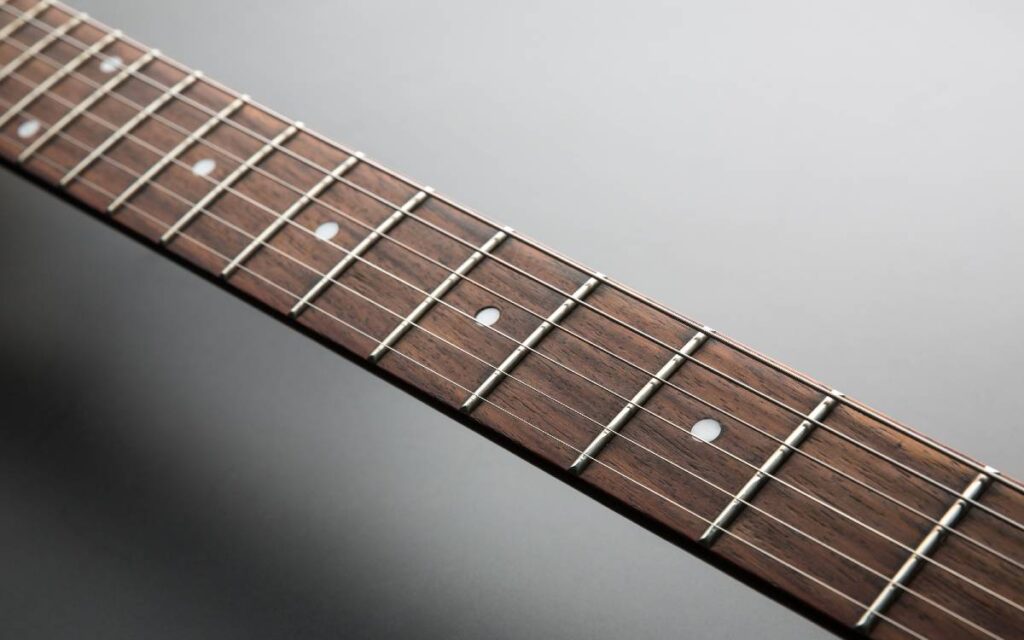
The fretboard is a layer of wood attached to the upper side of a guitar’s neck, and extends between the headstock at one end, and over the guitar body on the other end. It contains all the fret wires and inlays. The woods commonly used on a fretboard are usually maple, rosewood, ebony, or mahogany.
Rosewood fretboards are particularly favored for acoustic guitars, since they contain natural oils and reduce tension between the fingers and fretboard while playing. Rosewood also offers a warm tone.
The width of a fretboard is an important parameter that determines the spacing between the strings. You might find it easier to play open chords on a wider fretboard if you happen to have naturally thick fingers.
The scale length can also influence your playing experience. A fretboard’s scale depends on various factors, but switching from a short scale to a long one can feel like a completely new experience, with differences in string tension and spacing.
Fretboard radius can also influence your playing. A large radius can feel more suitable for playing scale runs, bends, vibrato, or single-note riffing. A small radius can feel more comfortable while playing chords. This is why some guitars have a ‘compound radius’, but this is rarely seen in acoustics.
With stringent environmental laws, rosewood is less commonly used. Manufacturers are switching to sustainable alternatives like engineered timber, which still offer brilliant sound.
Frets and Fret Wire
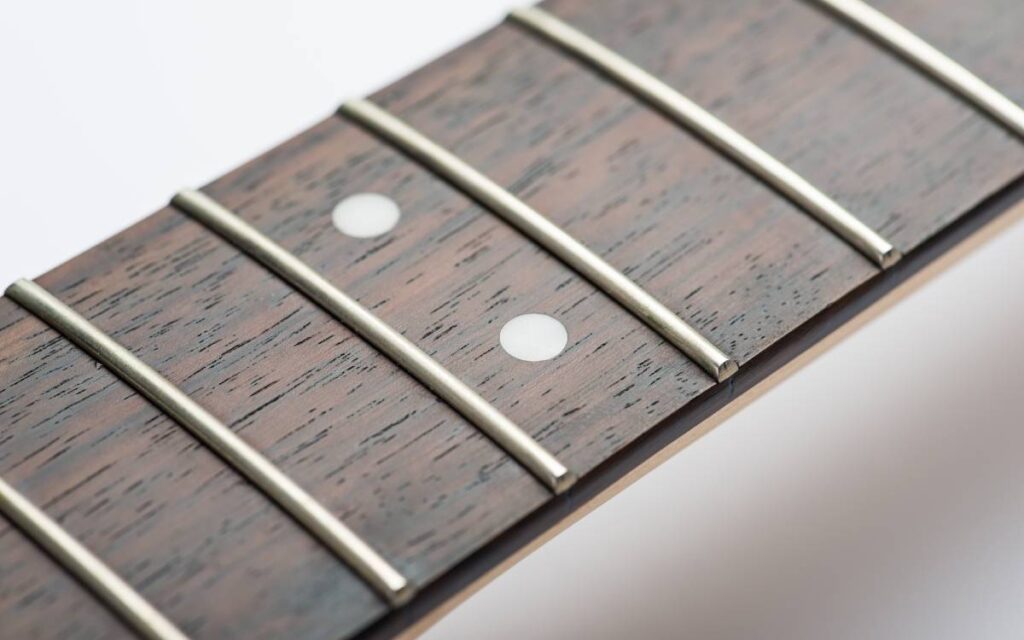
So, the terms ‘fret’ and ‘fret wire’ are often confused. Frets are musical – they divide the guitar into musical intervals that we use. Fret wires are physical – the actual strips of metal that segregate the fretboard into fixed regions.
Frets extend across the entire width of the neck of the guitar, and separate the guitar into semitone intervals of an octave.
When the string is placed against the fret, it shortens its length between the fretted point and the bridge. This helps the string resonate a note at the point where the string is pressed down on the fret. This creates a note, and it is easier to hit accurate notes on a fretted fingerboard than a non-fretted one.
Most acoustic guitars have somewhere between 18 and 20 frets, but only 12 are accessible on a non-cutaway body. Frets come in various shapes and sizes, and have a major impact on playability.
Frets also wear out over time, especially if you play regularly, so maintenance and repair are crucial. Otherwise, you’re likely to get fret buzz.
Strings

Guitar strings are perhaps the most important part of acoustic guitar anatomy, since you’ll be playing them every day. They are made from material like steel, nylon, copper, zinc, or even titanium. A classical guitar generally uses nylon strings., while electric guitars usually have nickel strings.
Acoustic guitars usually have all six strings made of steel a steel core. The strings at the lower end are wound around a plain string for more pronounced bass and thickness.
Each string on an acoustic guitar typically has a different thickness, from the thinnest E string to the thickest E string. Normally, strings 1 and 2 (E and B) are unwound, while the rest are wound. But with very thin gauges like .010, the G string is also a plain steel string.
Strings can be coated or uncoated. Coated strings generally have a longer life as they resist dust and grime build-up, and offer a warm, mellow tone. Uncoated strings have a bright, sharp tone.
Fret Inlays

Fret markers are also called fret inlays or positional markers. These are dots or custom marks situated on the guitar’s fretboard that point towards the specific frets and act as a visual aid to the player. These inlays can help the guitarist find notes quickly at just one glance.
These guitar inlays are typically found on the 3rd, 5th, 7th, 9th, 12th, 15th, 17th, 19th, and 21st frets. The twelfth (octave) fret is different from the others because it contains two dots instead of one to indicate the octave.
Inlays come in a wide range of shapes and designs. However, most acoustics have simple inlays like squares, trapezoids, or the evergreen ‘dots’.
They are made from a wide assortment of materials, including wood, abalone, plastic, or mother of pearl. Manufacturers are moving towards more sustainable materials for fret inlays as well.
Inlays are not usually found on classical guitars, which only feature fretboard side dots.
Neck Joint

The neck joint is also called the heel. It’s the part of the guitar where the neck joins the body and sides. In acoustic guitars, the neck is often glued via a traditional woodworking method using a dovetail joint.
The dovetail joint is a popular method of joining the neck, and has been around for hundreds of years. Several modern designs, most famously Taylor guitars, feature ‘bolt-on’ necks.
The traditional glued neck method is more efficient for sound transfer, while the modern bolting method makes repairs more hassle-free and affordable.
Acoustic guitar necks usually join the guitar body at the 12th or 15th fret.
Body (Front, Back, and Sides)
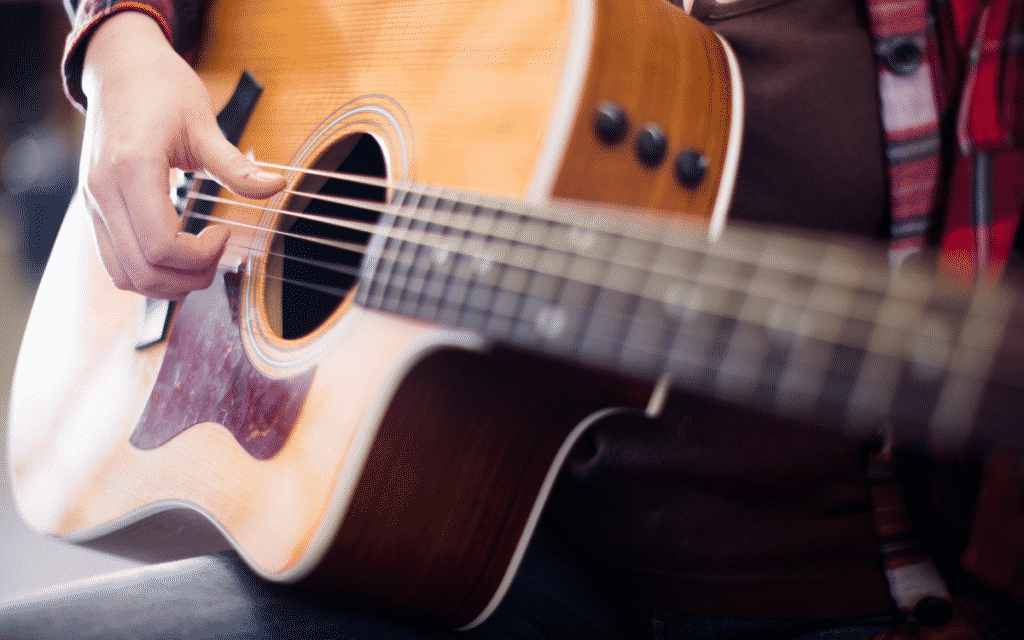
In the anatomy of an acoustic guitar, the body provides a home for the neck and bridge and provides a playing surface for the right hand. On an acoustic guitar, the body houses the sound chamber that amplifies the sound.
In terms of the anatomy of an acoustic guitar, the body of the guitar is hollow. It is made up of the soundboard, or guitar top, and the back and sides. In electric guitars, the body of the guitar is typically solid wood.
Spruce, red cedar, rosewood, maple, and mahogany are the common woods used in making acoustic guitars. The wood used for the top of the guitar is particularly important for its sound.
The back and sides of the guitar are paired. The back and the sides contribute to the guitar’s stability, while the soundboard is responsible for projecting sound due to its flexibility.
Since the vibrations of the soundboard are what produces sound in a guitar, the choice of top wood is critical for the guitar tone.
Parts of an Acoustic Guitar Body
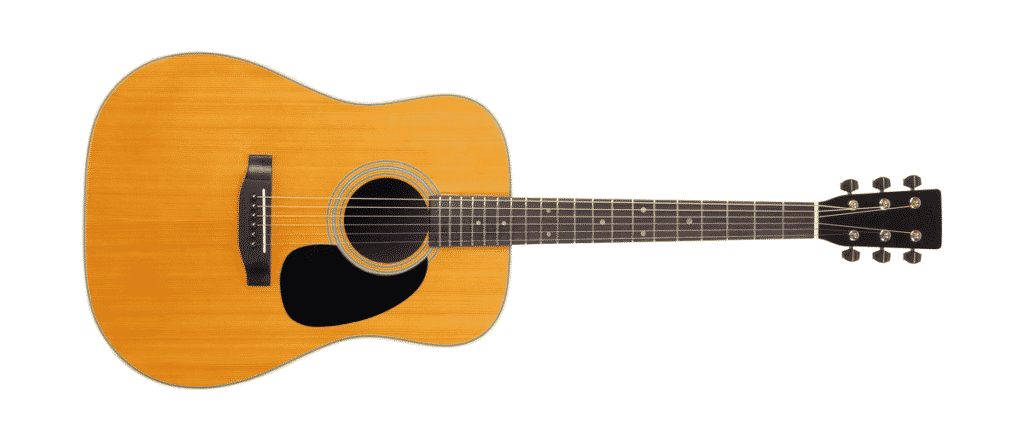
Guitar bodies come in many different shapes and sizes. But in all acoustic guitars, the body is divided into sections known as the upper bout, waist, and lower bout.
The upper bout is the top half of the guitar, and the lower bout is the bottom half. The waist is a narrow section in between the two bouts.
Bouts indicate the guitar’s width, with the lower bout being slightly larger than the upper bout.
The shape of the body affects the guitar’s tone, too, since it is influenced by the internal air resonance of the guitar. An acoustic guitar having a wide lower bout decreases air resonance and gives lower-end tones more definition.
Common body shapes in acoustics include jumbo, dreadnought, parlor, concert, and more, all with different body shapes and different tonal projections.
Cutaways are scooped indentations present in the guitar’s upper body. This can help you access the higher frets. The shape of the acoustic guitar determines how comfortably you can play it.
Sound Hole

Sound holes are precisely what they sounds like. They are openings on the guitar’s soundboard that help the guitar to project and produce sound.
The holes are circular in shape and frequently placed in the center of most acoustic guitars. In some jazz acoustic or electric guitars, F-shaped sound holes are also seen.
There are several other creative designs available too that are designed to create incredible vibrations and unique tones.
When using a microphone with an acoustic guitar, the sound hole is sometimes covered. This helps reduce feedback and noise.
Pick Guard
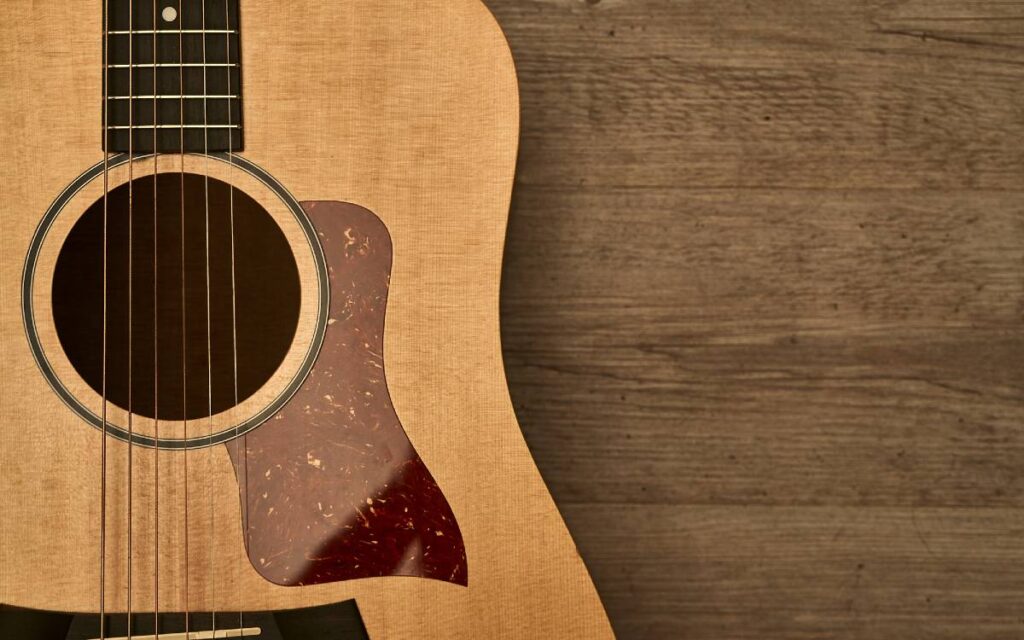
In an acoustic guitar, the pick guard or scratch plate is present just below the sound hole. It guards or protects the guitar’s body from constant assaults from the pick and fingernails, which would otherwise scratch the surface of the guitar and could ruin the beautiful finish.
Pick guards come in various sizes, and are constructed using plastic, vinyl, or three separately laminated pieces of ply.
Since classical guitars are not played with a pick, pick guards are not seen on these. Pick guards are kept very thin so as not to dampen the vibration of the soundboard.
Rosette

The rosette is the ornamental inlay pattern surrounding the sound hole. The rosette is not just cosmetic; it also reinforces and strengthens the timbers on the side of the soundboard, which would be otherwise prone to cracking.
The word rosette is said to be derived from the diminutive for “rose “in French. It’s seen in many stringed instruments beyond guitars as well.
Rosette patterns vary from traditional and ornamental to modern and simple. Makers often brand their lines with a specific rosette pattern unique to their guitars.
Bridge

In guitar anatomy, the bridge anchors the strings to the guitar’s body and helps the strings’ vibrations to resonate through the soundboard.
The bridge is as important as the nut, and determines how clearly the guitar strings can vibrate and sustain. The bridge also hosts the saddle, where the strings sit.
Bridges may be made of a single material, such as wood, commonly used in acoustic guitars. They may also include other materials like plastic or bone. On steel-string guitars, the bridge is usually glued to the top. Electric guitar bridges are typically metal and adjustable.
Bridge Pins
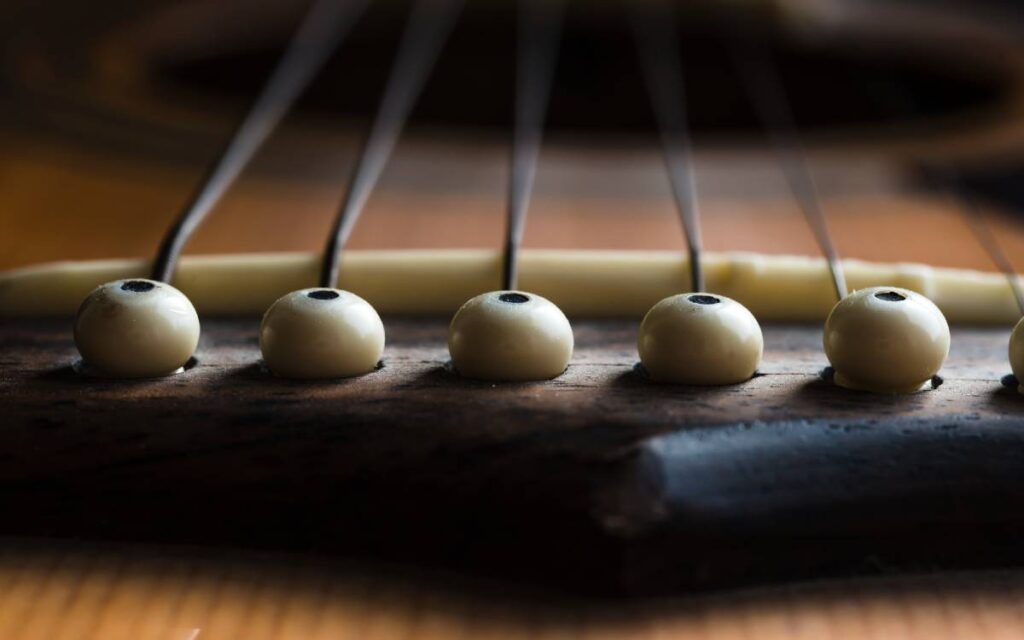
Bridge pins flying around while changing guitar strings is a nightmare many of us have dreaded (and even experienced!).
Bridge pins lock the strings in place after they are inserted through the small holes in the bridge. So bridge pins are essentially little pins that secure the strings on the bridge and prevent them from coming out. Once a string is properly brought up to tension, it positions itself, so bridge pins need not be tight or snug to be secure.
These pins are usually made of wood, bone, or synthetic materials, although there are specialized bridge pins made from other materials such as brass. The material used for pin construction often influences the guitar’s intonation, leaning it towards bass or treble.
Classical guitars are usually pinless, meaning they do not use bridge pins. Instead, the strings are fed through a hole in the bridge and tied around it.
Saddle
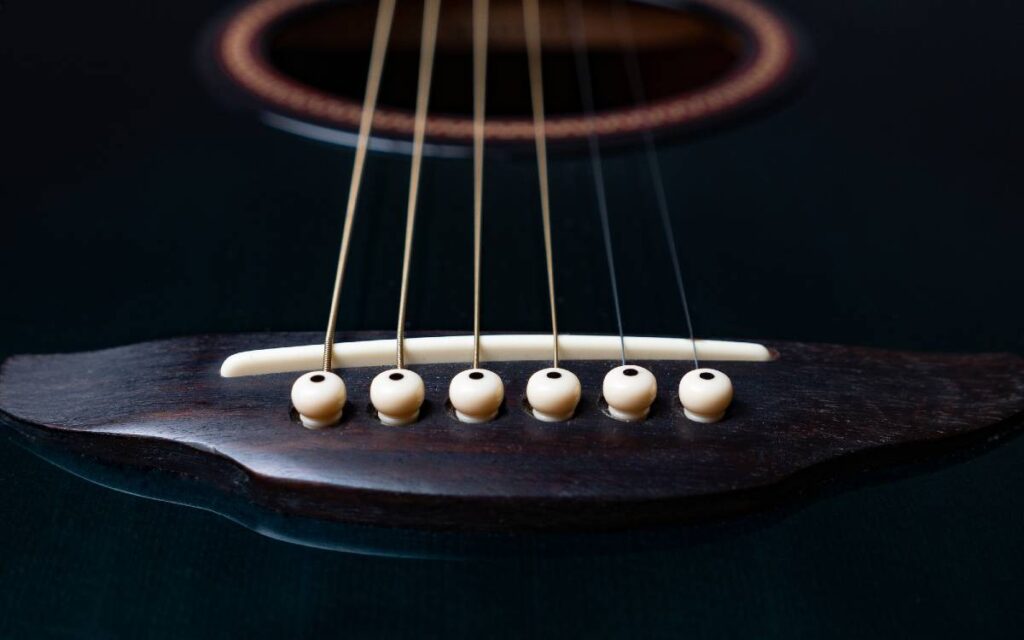
The saddle in your acoustic guitar is a piece of bone, plastic, or any type of hard material attached to the bridge. It elevates the strings to the correct height while transferring vibration to the soundboard through the bridge.
The saddle is generally made from the same material as the nut of the guitar. The saddle is slightly tilted on the bridge to aid intonation. The saddle’s height affects the “action” of the guitar, which is the distance between the strings and the fingerboard.
A good action is essential for the proper playability of a guitar.
The saddle is positioned such that the ends near the bridge pins are reserved for the bass strings. This ensures proper intonation across the fretboard. A good saddle means the open string will vibrate clearly.
Bracings
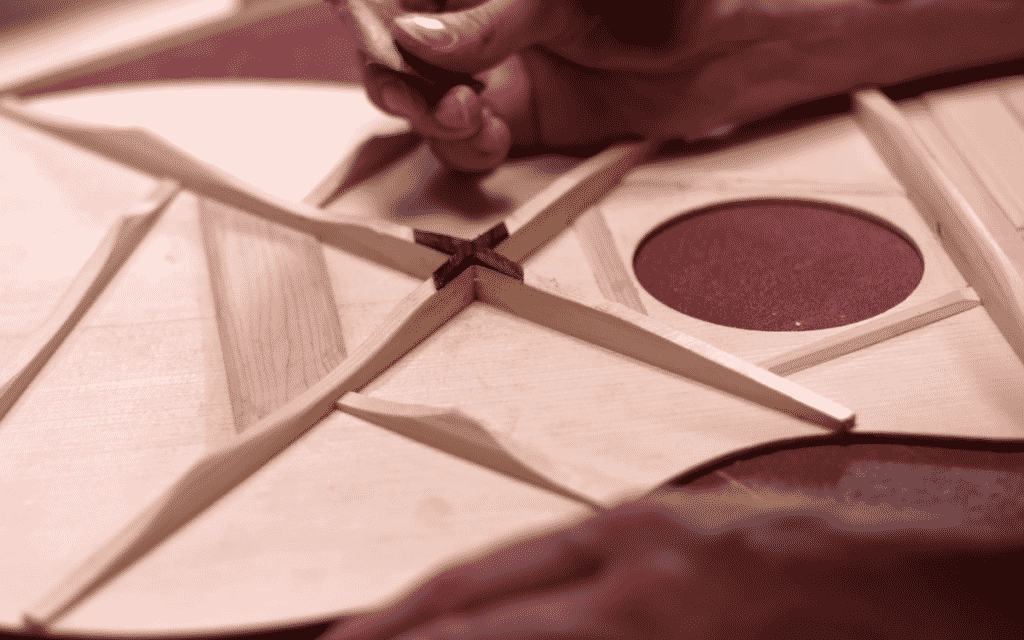
Bracings are an essential component of your acoustic guitar anatomy because they affect the guitar’s strength and tone. But what are bracings?
Bracings are wooden struts attached to the underside of the guitar’s soundboard and back. Bracings are typically made up of spruce, or a similar light yet strong timber.
There are many different types of bracings, and each style gives a distinct tone to the guitar.
The bracing is vital, as it adds the necessary strength to the top and back of the guitar. It is also equally important to make sure that the bracing does not hamper the sound quality in any way. The bracing needs to aid and support the soundboard and not restrict its vibrations.
Bracing supports large and lighter sections of the timber without adding much weight in itself. A heavy bracing would hamper the guitar’s ability to resonate. Scalloped struts further reduce the weight, and are an essential technique to keep the weight of the bracing down without compromising its structural integrity.
The X bracing is the most common kind of brace. It is primarily used in steel-string guitars.
Another variation of bracing is ladder bracing, where the struts are fixed to a central strut in a perpendicular direction in the manner of a ladder.
Classical guitars employ a method called fan bracing. These bracings add strength to the top, while at the same time allowing the top to vibrate, having a distinct effect on the guitar’s sound.
A bracing can make or break the sound of a guitar. Correctly done bracing gives a guitar a unique tonal quality, while poorly done bracing can yield disastrous results.
Strap Pins

Strap pins are round pieces screwed to the body of your guitar that allow you to attach a strap for playing your instrument standing up.
There is typically one strap pin attached near the neck joint, although some guitars require that you attach the strap to a loop of string around the headstock.
A second strap pin – or end pin – is attached at the bottom of the guitar (the end pin may also include a jack for plugging into an amp).
Pickups and Electronics
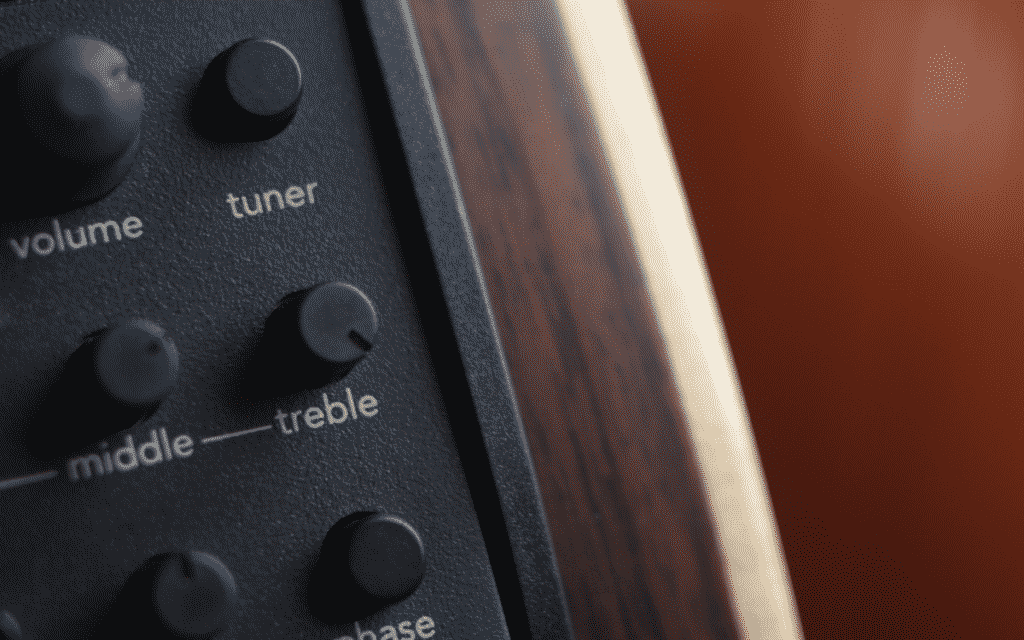
Acoustic-electrics are becoming more and more common. These guitars include various types of pickups that give you the ability to plug your guitar into an amplifier for playing with a band or for a crowd.
There are different types of pickups, some of which sit under the saddle, and other which attach underneath the top.
There is also typically a preamp either in the body or sound hole of the guitar, and this may even include an onboard tuner.
How Do Acoustic Guitars Differ the Electric Guitar?

Although an electric guitar is a similar instrument with many similar parts, they differ in some important ways.
Electric guitars are typically solid body, although there are hollow body versions. They also have more freedom in body shape, since there is not internal cavity to affect the sound.
Many components, such as the bridge and saddle, are constructed differently, and typically made of metal instead of wood. And, of course, there are pickups, control knobs, and other electronics.

